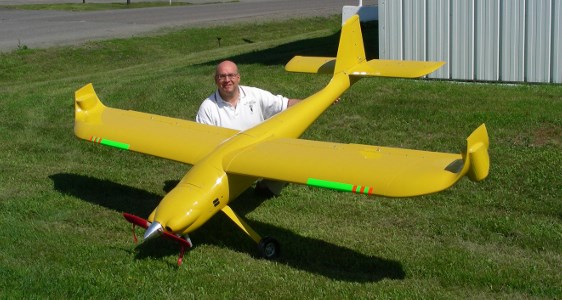These aren't your radio-controlled hobby planes anymore and a Thunder Bay entrepreneur is poised to benefit from an emerging international market.
Unmanned aerial vehicles (UAV's), also known as drones, are catching a lot of attention for their military and surveillance applications in the world's war zones.
Andrew Kondor, a Thunder Bay designer and maker of UAV's, is looking to have a breakthrough year into the defense industry sectors with a patented technology that's on the verge of being market-ready.
Armed with a new variable pitch propeller system for UAV's, he was meeting in late March with National Research Council officials in Ottawa about upcoming tests of the technology in order to be ready for a huge industry trade show in Washington D.C. this summer.
"We're desperately trying to get our testing all done, our numbers in line and our production ready pieces so that we can showcase our product this August."
Kondor and his company, Aerovate, has enjoyed some success in making UAV's for Universal Wing Geophysics Corp., a Vancouver airborne line-surveying company that uses them for mineral exploration.
His airframes are made and shipped from a factory in southern China to his distribution warehouse in Florida, where he employs two. Thunder Bay is the sales office.
Kondor began in the radio-controlled model airplane business and runs an internationally successful retail hobby shop in Thunder Bay -- Kondor Model Products -- selling vintage and Second World War classic aircraft.
After years of seeing deficiencies in model kits, Kondor began making his own air frames, using composite material and pioneering a flat finish to give hobby airplanes a glossy showroom polish.
His own brand has sold so well it's become 90 per cent of his sales. The spinoff business, Aerovate, handles the commercial uses of these types of aircraft. The opportunity to delve into UAV's arrived out of the blue five years ago when Universal Wing found him through Google.
The Vancouver company was looking for help to iron out some design kinks on their own UAV. As well their Seattle parts supplier was unreliable and expensive. "They were hunting for a bush plane version of a UAV," said Kondor.
He makes an exclusive model for them called the Thunder Child. The 45-pound fibreglass and wood airframe has a 13-foot wingspan. It is powered by an 85 to 106 CC twin-cylinder engine, can carry up to 40 pounds and can stay aloft for six to seven hours.
Kondor makes and sells them the airframes, pre-mounts the engine and electronics. Universal Wing attaches the navigational and geophysical gear to perform aerial work for clients.
The airframe contains no ferrous materials to minimize the impact on Universal Wing's magnetometers. The next version, Thunder Child 2, will be completely composite.
Universal holds the Thunder Child's exclusive rights, but Kondor still retains the intellectual property. He is free to do custom designs for anyone, just give him your UAV requirements for payload, speed, altitude and range specifications.
UAV's have other applications in search and rescue operations, border patrol and airborne research work.
Just like a helicopter or fixed wing aircraft, UAV's can carry electronic gear such as geophysical equipment, radar, cameras, infrared and heat sensors. They can fly at night, in stormy or foggy weather, and can perform in conditions and places that would be risky for pilots.
"We can develop to a customer's specifications, whatever it is that they want to carry."
But military clients are his No. 1 targeted area when he heads off on the trade show circuit this summer.
What has him excited is his patent pending on a passive variable pitch propeller system for UAVs. It's a self-adjusting prop allowing an aircraft to change its pitch in flight without input from electronic controls or an operator on the ground.
"When a propeller can change pitch it can take advantage of being more efficient in different parts of flight."
By working with Sensenich Propellers, a premier U.S. manufacturer of high tech prop systems, he's hoping it will open some doors for contracts with big defense contractors.
"Having a world renowned brand name (in Sensenich) associated with our system helps catapult (us)."
Kondor has invested $200,000 in his project and is looking to raise $300,000 to showcase a production-ready product at shows like the Association for Unmanned Vehicle Systems International in Washington.
It's a huge event attended by the U.S. military and major defense contractors like Lockheed Martin, Boeing, Northrup-Grumman and Raytheon, a few of which Kondor has had dealings with.
One investor group has pledged support provided the system works. "I know we have a deal pending I just need a few more results coming in within the next few weeks."
There's also some interest coming from the U.S. Army and Israel Aerospace Industries.
Kondor acknowledges the financial and business support he's received through the federal Industrial Research Assistance Program -- which has provided $10,000 in grants -- and from staff at the Northwestern Ontario Innovation Centre who walked him through a business plan and introduced him to the Northern Ontario Enterprise Gateway investor network.
Kondor said he could easily re-locate Aerovate to the U.S. but Thunder Bay remains his family's home. The city and its frigid winter weather offers the perfect proving ground for testing since most UAV work is geared to the bush.
So wide open is the UAV market opportunity, that within a year, he intends to create some high tech jobs with a local research centre using aviation graduates from Confederation College to assist in aircraft manufacturing and composites work.
On the web:
www.aerovate.com
www.kmp.ca (Kondor Model Products)




